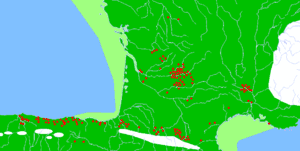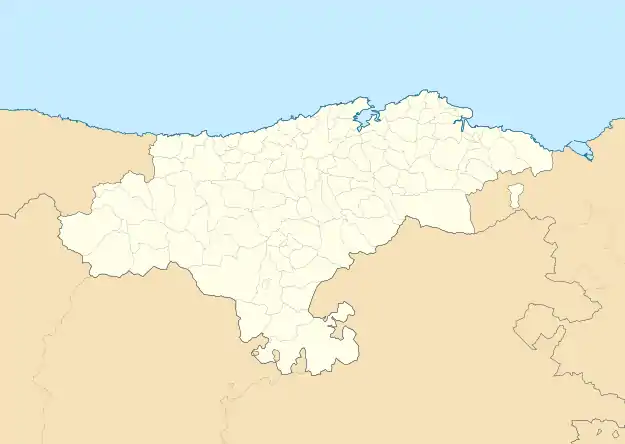Cave of Chufín
The cave of Chufín is located in the town of Riclones in Cantabria (Spain). Situated at the confluence of the Lamasón and Nansa rivers, several caves ornamented with rock art pock the steep slopes above the water. Chufín is one of the caves included in UNESCO’s list of World Heritage sites under the entry “Cave of Altamira and Paleolithic Cave Art of Northern Spain.”
| UNESCO World Heritage Site | |
|---|---|
 | |
| Location | Riclones, Rionansa, Cantabria, Spain |
| Part of | Cave of Altamira and Paleolithic Cave Art of Northern Spain |
| Criteria | Cultural: (i), (iii) |
| Reference | 310bis-007 |
| Inscription | 1985 (9th session) |
| Extensions | 2008 |
| Buffer zone | 16.65 ha (41.1 acres) |
| Coordinates | 43°17′26″N 4°27′29″W |
 Location of Cave of Chufín in Cantabria  Cave of Chufín (Spain) Show map of Spain | |
It was discovered by the photographer Manuel de Cos Borbolla, a native of Rabago (Cantabria).
In Chufín were found different levels of occupation, the oldest being around 20000 years old. The small cave has some subtle engravings and paintings of red deer, goats, and cattle, all represented very schematically.
Also found in the cave were many symbols. One group, called type "sticks", accompanies the paintings inside animals. There are also many drawings using points (puntillaje), including one which has been interpreted as a representation of a vulva.
External links
- Human Timeline (Interactive) – Smithsonian, National Museum of Natural History (August 2016).
| Taxonomy (Hominins) |
| ||||||||||||||||||||||||||
|---|---|---|---|---|---|---|---|---|---|---|---|---|---|---|---|---|---|---|---|---|---|---|---|---|---|---|---|
| Ancestors |
| ||||||||||||||||||||||||||
| Models |
| ||||||||||||||||||||||||||
| Timelines | |||||||||||||||||||||||||||
| Others |
| ||||||||||||||||||||||||||
| |||||||||||||||||||||||||||
| |||||||||||||
| |||||||||||||
Prehistoric cave sites, rock shelters and cave paintings | |||||||||||||||||||||||||||||||||||||||||||||||||||||||||||||||||
|---|---|---|---|---|---|---|---|---|---|---|---|---|---|---|---|---|---|---|---|---|---|---|---|---|---|---|---|---|---|---|---|---|---|---|---|---|---|---|---|---|---|---|---|---|---|---|---|---|---|---|---|---|---|---|---|---|---|---|---|---|---|---|---|---|---|
| |||||||||||||||||||||||||||||||||||||||||||||||||||||||||||||||||
| |||||||||||||||||||||||||||||||||||||||||||||||||||||||||||||||||
| |||||||||||||||||||||||||||||||||||||||||||||||||||||||||||||||||
| |||||||||||||||||||||||||||||||||||||||||||||||||||||||||||||||||
| |||||||||||||||||||||||||||||||||||||||||||||||||||||||||||||||||
| |||||||||||||||||||||||||||||||||||||||||||||||||||||||||||||||||